 1/2 Our last night in Penang, I went back to Gurney Drive to try the pasembur that I missed the first time. Sadly, the stall wasn’t open and on this weeknight, only half the seating was out creating a madhouse, scrambling for tables effect. What else was nearby? We walked down to Bali Hai, a sprawling outdoor seafood restaurant with a flashy neon sign and a wall of choose-your-own-creature fish tanks.
1/2 Our last night in Penang, I went back to Gurney Drive to try the pasembur that I missed the first time. Sadly, the stall wasn’t open and on this weeknight, only half the seating was out creating a madhouse, scrambling for tables effect. What else was nearby? We walked down to Bali Hai, a sprawling outdoor seafood restaurant with a flashy neon sign and a wall of choose-your-own-creature fish tanks.
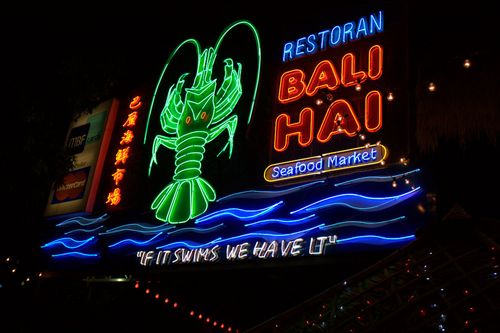
Also, popular in Hong Kong and Singapore, I’d always shied away from this style of dining because quickly calculating grams to ounces while simultaneously doing currency conversions makes me nervous and I’m paranoid that I will end up with a massive bill. This did end up being our most expensive meal in Penang but even with three large sharable Calsbergs (the territorial aspect of SE Asian dining always throws me. When approached by the Indian woman dressed in a green miniskirt ensemble we asked for Tiger beer, but she was the Carlsberg server. You had to order from the Chinese Tiger beer girl if you wanted Tiger. Meanwhile, there was a rogue satay guy who didn’t seem to have any affiliation with the restaurant) it was under $50.

The covered open space, sticky despite fans blowing water, was filled with large round tables, many occupied by groups of men, coworkers, showing a Westerner, maybe a boss, maybe a peer, a good time. The primo spots were thatched hut booths in the front. We had a roomy picnic-type table on the outer perimeter.
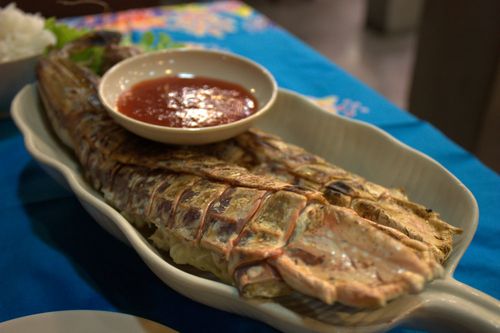
Mantis prawns. I’ve always wanted to try these giant crustaceans, despite their creepy name and buggy, armored appearance. Not inexpensive, these were about $10 apiece. The impenetrable shells come scored, diners are brought scissors. I copied the guy at a table near ours and scraped out the meat with a spoon. It turned out to be a lot of work for not a lot of payoff, like blue crabs. The chili sauce was barely touched because I couldn’t wrangle any tidbits substantial enough for dipping.
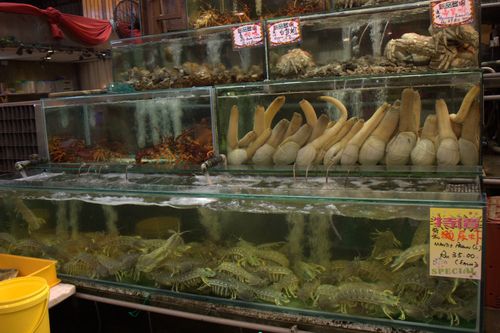
Here are some live mantis prawns in action. As you can see, they also had quite a selection of geoduck. The prehistoric-looking animals are often touted as a Northwest delicacy but I never encountered them in Portland and have still yet to try them. I’m not sure how they are served in Malaysia.
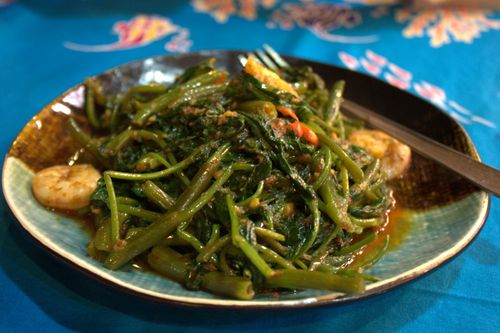
Kang kong, a.k.a. water spinach, prepared with shrimp paste and chile is a typical Malaysian vegetable. Accents are very subtle. Our waiter, who had to be sent over to our table because he was the only fluent English-speaker, had no idea what I was asking for when I said kang like in kangaroo. A’s are softer like in almond; his pronunciation was more like kong kong, the A barely different from the O. My pronunciation of pandan was corrected on my last visit to Malaysia, so you think I would’ve remembered. Normally, I hate stems and try to avoid them raw. This style of water spinach is so savory and hearty that I forgot about being scared of the hollow stems.
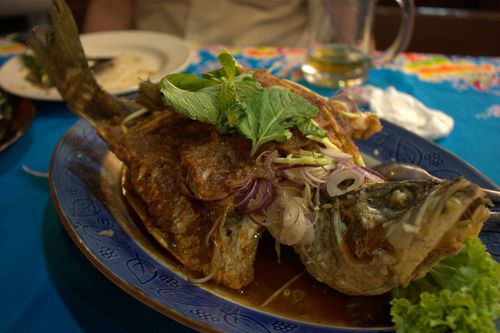
I picked out a sea bass that would be good for two, like I said, grams don’t mean anything to me visually. This fish, fried to a crisp, was amazing and almost Thai in flavor. It was served with a very spicy green mango slaw and lots of shallots and mint leaves.
Despite a substantial amount of blog posts and having their own website, I have no idea what Bali Hai’s address might be of if they even have one. Such details seem superfluous in much of Southeast Asia.
Bali Hai Seafood * Gurney Dr., Penang, Malaysia
 As much as I love the malls of Asia and organized hawker centers, there is something to be said for the weak breezes of an electric fan while sitting on hard wooden booth in a well-worn shophouse. Cooling off with an ais kacang, of course.
As much as I love the malls of Asia and organized hawker centers, there is something to be said for the weak breezes of an electric fan while sitting on hard wooden booth in a well-worn shophouse. Cooling off with an ais kacang, of course.





 Follow
Follow



























 Unlike
Unlike 






























